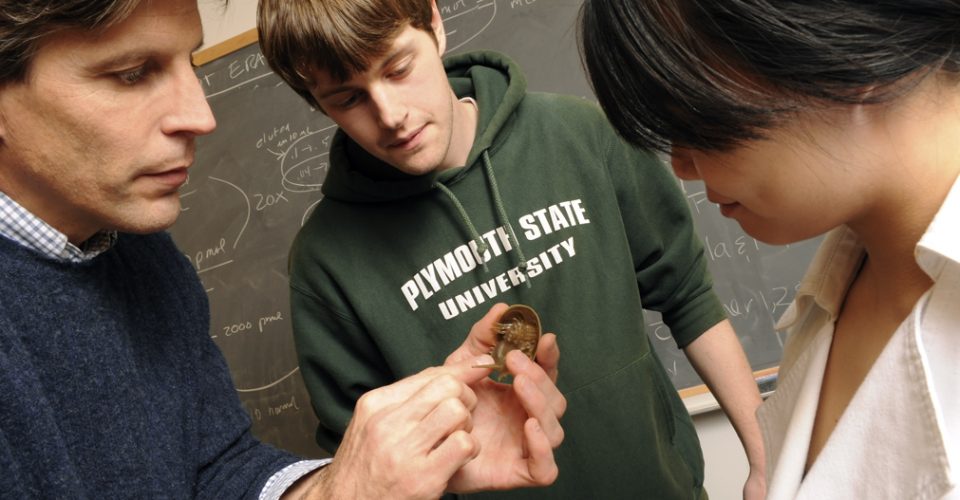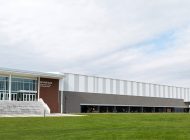PSU joins forces with other New Hampshire colleges and universities to strengthen biomedical research infrastructure statewide.
by Barbra Alan, photos by Jon Gilbert Fox
EVEN IN THE BEST of economic times, it can be a challenge for higher education institutions in rural areas to compete with clusters of urban institutions for federal research dollars. Thanks to a program from the National Institutes of Health (NIH), colleges and universities have the opportunity to create statewide biomedical research networks to more effectively compete for federal funding and increase innovation in health research.
The mission of the IDeA Network of Biomedical Research Excellence (INBRE) program is to increase research opportunities for faculty and students across individual states. Recently, PSU joined nine other New Hampshire colleges and universities to form NH-INBRE, which has been awarded $15.4 million to fund research programs from its member institutions over the next five years. Of the 12 research projects selected for NH-INBRE funding, three are from PSU faculty: Professor of Biology Chris Chabot, Professor of Microbiology Katie Rose Boissonneault, and Professor of Athletic Training Marjorie King.
A Matter of Time

Chabot indicates photoreceptors on a juvenile horseshoe crab to students Matt Sebas and Shiwha Park.
Nearly every living organism on Earth, from bacteria to human beings, has biological clocks that help regulate such functions as eating, breathing, and sleeping. In fact, most of physiology is to some extent under the control of a clock. The circadian (from the Latin for “around a day”) clock keeps organisms synchronized to the 24-hour daily cycle of light and dark and is considered to be the master clock.
While scientists have been aware of circadian rhythms since the early eighteenth century, and the field of circadian biology has been in existence since the mid-twentieth century, there is still much to be learned about this molecular timepiece. Gaining a greater understanding of the clock and its genetic makeup could lead to advances in the treatment of disorders that result from malfunctions in the clock, including seasonal affective disorder, bipolar disorder, and even forms of schizophrenia. There is also evidence suggesting that an understanding of the circadian clock is crucial in designing effective cancer treatments.
Most of Chris Chabot’s career has been devoted to studying biological clocks. During a sabbatical working with UNH Professor of Biology Win Watson in 1998, Chabot teamed up with Watson to study the molecular mechanisms of and interactions between circadian clocks and circatidal clocks in Limulus polyphemus, commonly known as the American Horseshoe Crab. Many of the early discoveries about circadian clocks are from researching arthropods like the horseshoe crab, which has been roaming the Earth virtually unchanged for more than 400 million years.
Good research, says Chabot, always generates new questions and ideas. But some of the questions and hypotheses that had been generated by his most recent research, funded by grants from the National Science Foundation, were outside of the scope of the NSF. Chabot explains, “The NSF is more concerned with basic science, and discovery for the sake of understanding fundamental biological mechanisms, rather than discovery that translates more directly to human health issues. We didn’t have the funding to answer all of the questions that were being generated by our research, so we set them aside, with the idea of putting them together at some point for a future research grant proposal. And then the opportunity to participate in the NH-INBRE program came along.”
The grant, which will fund Chabot’s research for five years, provides funds for supplies and equipment, a half-time release from teaching so he can spend more time in the laboratory, and support for undergraduate student researchers. For Chabot, the ability to provide students with paid, year-round research opportunities is exciting. “It means that they can earn money doing scientific research and working toward their degree.”
Chabot also appreciates the opportunity to build upon his collaboration with Win Watson and embark on new collaborations with UNH’s Charles Walker, a professor of molecular biology whose research emphasis is clam cancer biology, and the Dartmouth Medical School’s Jennifer Loros, a professor of biochemistry and genetics who for the past 25 years has studied the circadian clocks in the fungus Neurospora crassa. Chabot and his students have access to laboratories and equipment at both institutions, and Watson, Walker, Loros, and Chabot are a team. “It’s an incredible opportunity for PSU, for me, and especially for the students.”
Helping Seniors Achieve Balance

Professor Emerita of Physical Education Dorothy Diehl tests her balance with the assistance of undergraduate student Ryan Kempson as graduate student Marie Trombulak views the results.
Each year in the US, one in three seniors falls. About one in 10 falls results in a serious injury, such as a broken hip or head injury, which requires hospitalization. Over the years, direct medical costs for fatal and non-fatal injuries have soared into the billions of dollars. As the senior citizen population increases dramatically over the next few decades, so will the economic burden of falls.
The good news is that falls are preventable, and researchers like Marjorie King, professor of athletic training and sports medicine, are finding ways to not only assess the risk of falling in seniors, but also help them improve their balance to help prevent falls.
Among King’s research interests are core and postural stability and injury prevention. One of her more recent research projects has focused on posture and balance testing of student-athletes. When she learned of the NH-INBRE call for proposals, she decided to explore the possibility of testing posture and balance in senior citizens.
In collaboration with Barbara McCahan, director of the Center for Active Living and Healthy Communities (CALHC)—PSU’s locus for research and outreach on health and wellness in rural areas—King wrote a proposal for verifying the reliability of the testing equipment in the senior population. “You can’t just assume that, because it works well and is viable for a 20- and 30-year old population, it is going to work for people 60, 70, or 80 years old,” says King.
The equipment, which is portable and takes up little space, includes a 3-foot by 3-foot floor mat that captures foot pressure data, a laptop, and a connector that transfers the data from the mat to the laptop. Pressure sensors on the mat measure where each subject moves her center of mass to achieve equilibrium. “When we stand still, we sway in an elliptical pattern,” says King. “For most of us, the sway is barely perceivable. The mat scan measures this information, and the Sway Analysis Module software applies it to a graph, creating an ellipse of the area in which the subject swayed. Then it calculates the area of the ellipse, the area needed to control the body’s center of mass without falling.”
In keeping with the goals of INBRE, students are part of the entire process, says King. Graduate student Marie Trombulak, along with undergraduate students Bill Eissler and Ryan Kempson, conducts tests all over the state. The CALHC works with the testing sites to recruit volunteers. “Our target group is seniors 55 and older who live independently,” says Trombulak. “We’ll test seniors at each location on a Monday, Wednesday, and Friday of the same week.”
“We need to make sure that the information we collect, independent of the day, is consistent,” adds King, noting that testing subjects are asked not to practice at home in between test days. The following week, Eissler and Kempson return to the testing site with test results and recommended exercises for each test subject.
While the goal of this NH-INBRE grant is to demonstrate the reliability of the testing equipment with the senior populations, King is already anticipating the long-term implications of her work. “If this [phase] is successful, we’re going to make a difference in the lives of a lot of people in a short period of time,” she says. “And because the testing is quick and produces quantifiable data, I’d think insurance companies would consider covering the testing procedure. Ideally, anyone with Medicare could go for balance testing and have it covered. That way, we would be able to identify the people who are at risk for falling and refer them for rehabilitation. Preventing falls would be a wonderful thing.”
Closing in on Toxin Triggers

Pam Felie (left, with Boissonneault) pours a low-melt agarose gel that will be used to recover distinct bands of DNA to isolate a transporter gene of interest in the Ps-n study.
In late 1987, three deaths and more than 100 illnesses were traced to the consumption of cultivated mussels harvested from Cardigan Bay, Prince Edward Island. The mussels were contaminated with domoic acid, an amino acid that in high doses is highly toxic, causing gastroenteritis, disorientation, memory loss, and in some cases, coma and death. Because this toxin affects nerve cells in the brain associated with memory retention, domoic acid poisoning is also known as amnesic shellfish poisoning (ASP).
Since that outbreak more than 20 years ago, ASP has remained a threat to consumers of shellfish and hence the shellfish industry, not only in northern North America, but also throughout the world’s oceans.
Professor of Microbiology and Genetics Katie Rose Boissonneault has been working on characterizing the genes that are involved in toxin production in the marine alga Pseudo-nitzschia multiseries (Ps-n), the source of domoic acid, since she was a graduate student. When she came to PSU in 2008, she brought her research with her, giving her students the opportunity to work with her on an ongoing research project with real-world implications.
When Boissonneault learned of the request for proposals for NH-INBRE, she was eager to apply. “It was exciting to have an opportunity to apply for funding to support the research I came to PSU with and expand on it with my students,” she says.
Like Marjorie King, Boissonneault was awarded a two-year pilot grant. “The goal of the research is to characterize the genes that are involved in toxin production in the alga, and to look at gene expression and how those genes are turned on and off,” says Boissonneault. “What triggers the genes to produce the toxin?”
By understanding the causes of toxin production in Ps-n, Boissonneault says, “We can better predict and monitor toxin production in the algal populations, which will help improve our ability to avoid and mediate events that have had severe effects on human health
as a consequence of domoic acid production.”
The aim of her NH-INBRE project is to develop a gene transfer system in Ps-n, which will allow further characterization of the toxin-related genes. The grant funded the acquisition of lab equipment crucial to advancing Boissonneault’s research, including a gene gun and fluorescence microscope. “The alga has a glass shell around it, and the gene gun shoots the plasmid that carries the gene we’re trying to introduce into the alga’s cells,” she explains. “The fluorescence microscope allows us to look at the alga’s chloroplast, chlorophyll, and cell structure, and help us tag genes to look at where they are located in the cells.”
While she’s excited at the prospect of furthering her research, the most meaningful aspect of the NH-INBRE grant to Boissonneault is the support it gives for undergraduate student research. “I came to PSU because I wanted to work closely with undergraduates,” she says. “And this research is ideal for undergraduates because it encompasses traditional growth experiments, culturing techniques, microscopy, and advanced molecular techniques, while offering the resources and hypotheses to guide future experiments and provide a framework for continued investigations.”
Boissonneault also appreciates the collaborations she has developed with researchers at Dartmouth Medical School, specifically Professor of Microbiology and Immunology Deborah Hogan, who serves as her NH-INBRE mentor. “She’s been very helpful throughout the whole proposal process, and has been very gracious in allowing my students and me access to her facilities,” says Boissonneault, adding that she also maintains her long-term collaboration with David Housman, her former advisor and biology professor at MIT, where she earned her graduate degrees and completed post-doctoral research. PSU, she says, “is perfectly situated to work with both institutions.”
While science and medicine will have to wait to benefit from the work that Chabot, King, Boissoneault and their students are doing, the benefits of collaboration are already being realized by the NH-INBRE institutions, their faculty, and especially their students, many of whom will be among the next generation of scientists.
Top: Chabot indicates photoreceptors on a juvenile horseshoe crab to students Matt Sebas and Shiwha Park.
Center: Professor Emerita of Physical Education Dorothy Diehl tests her balance with the assistance of undergraduate student Ryan Kempson as graduate student Marie Trombulak views the results.
Bottom: Pam Felie (left, with Boissonneault) pours a low-melt agarose gel that will be used to recover distinct bands of DNA to isolate a transporter gene of interest in the Ps-n study.
Tags: amnesic shellfish poisoning balance biological clock biomedical research Center for Active Living and Healthy Communities Chris Chabot circadian rhythms circatidal clocks collaboration Diehl domoic acid horseshoe crabs Katie Rose Boissonneault Marjorie King McCahan National Institutes of Health NH-INBRE Ps-n Pseudo-nitzschia multiseries seniors










